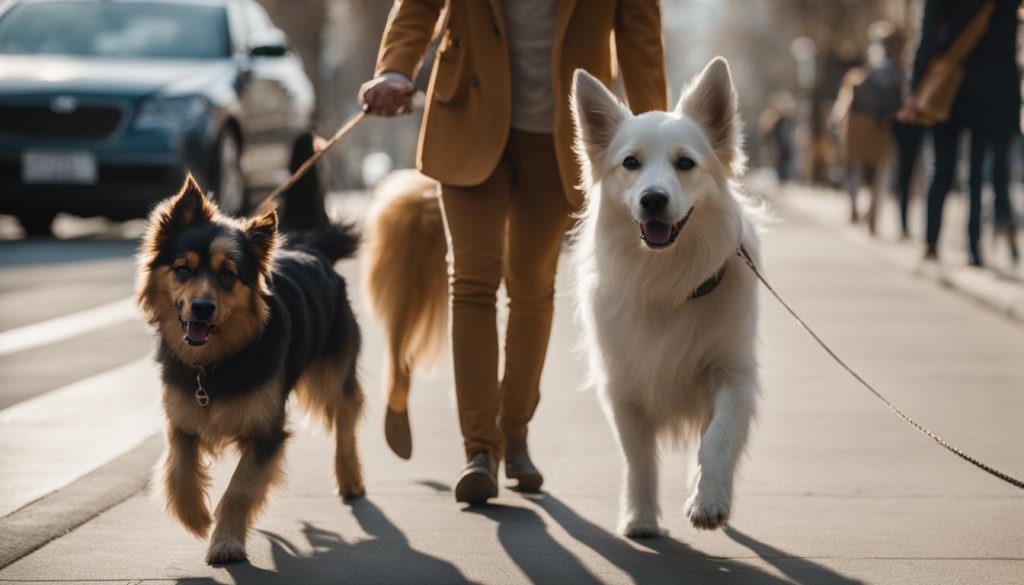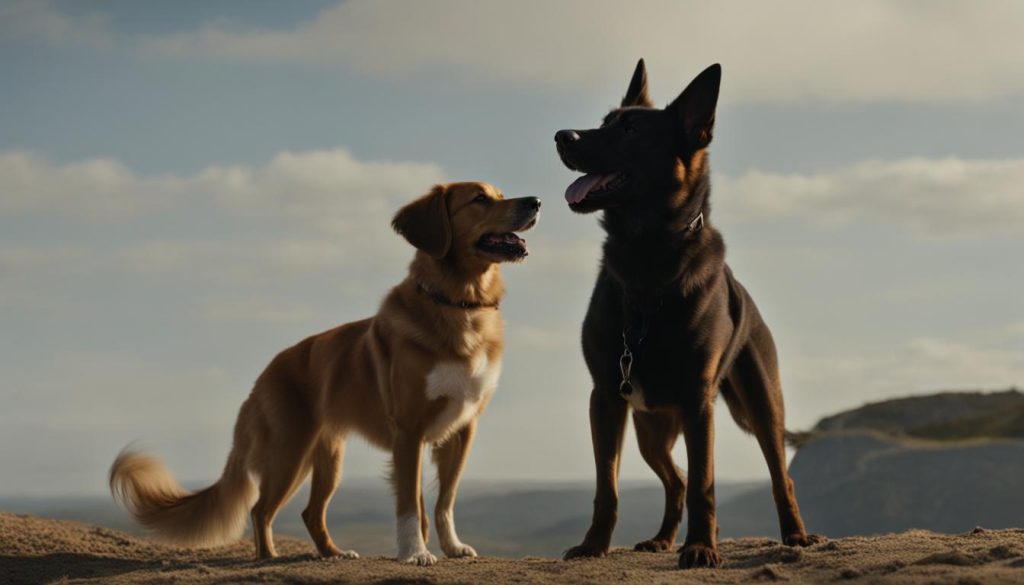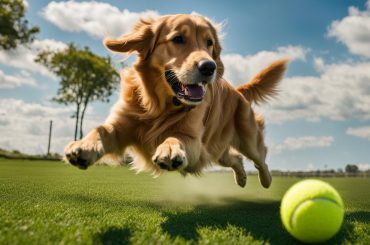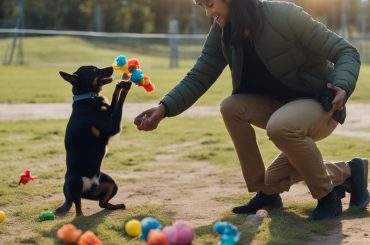If your dog displays anxious or aggressive behavior around other dogs, it is recommended to seek help from a qualified canine behaviorist. Anxious and aggressive behaviors often stem from fear, and simply exposing a scared dog to other dogs over time may not resolve the issue. You should understand your dog’s body language and find a suitable trainer or behaviorist to address the problem. When walking your dog, there are steps you can take to ensure positive interactions with other dogs, such as practicing loose-lead walking and promoting good manners during greetings.
Key Takeaways:
- Seek help from a qualified canine behaviorist if your dog displays anxious or aggressive behavior around other dogs.
- Understanding your dog’s body language is crucial in addressing behavioral issues.
- Practice loose-lead walking and promote good manners during greetings to ensure positive interactions with other dogs.
Importance of Teaching Your Dog to Greet Other Dogs Nicely
Teaching your dog to greet other dogs nicely is crucial for their socialization and overall well-being. It reduces stress during walks and allows you to bring your dog to places with other dogs. Polite greeting behavior can prevent your dog from getting into fights and increase their chances of participating in advanced training programs. While some dogs naturally pick up this behavior easily, others may require more time and patience. Starting early and using positive reinforcement techniques can help your dog develop polite greeting skills.
Proper dog socialization has many benefits. Dogs that are well-socialized are generally more confident and adaptable in different environments. They are more likely to exhibit friendly and calm behavior around other dogs, reducing the risk of conflict. Socialized dogs also have a better chance of forming positive relationships with other dogs, which can lead to more enjoyable and enriching interactions. Teaching your dog proper manners during greetings can contribute to a positive and harmonious dog community.
During dog greetings, you should be aware of your dog’s body language and to promote respectful interactions. Encouraging your dog to approach other dogs from the side rather than face-to-face can help prevent confrontations. Additionally, respecting other owners’ wishes and using the three-second rule for introductions can ensure positive interactions between dogs. By teaching your dog to greet other dogs nicely, you are not only promoting their well-being but also contributing to a safer and more enjoyable experience for all dogs and their owners.
| Benefits of Teaching Your Dog to Greet Other Dogs Nicely |
|---|
| Reduces stress during walks |
| Allows for more places with other dogs |
| Prevents fights and conflicts |
| Increases chances of advanced training participation |
| Builds confidence and adaptability |
| Promotes positive relationships with other dogs |
| Contributes to a harmonious dog community |
Loose-Lead Walking and Dog Greetings
When it comes to teaching your dog to greet other dogs, loose-lead walking is an essential skill. By training your dog to walk comfortably on a loose lead, you can maintain better control and redirect their attention during greetings. This technique is recommended for all dogs, helping to prevent unwanted behaviors and promote positive social interactions.
During dog greetings, assess whether it’s appropriate for your dog to say hello. Encouraging side-on approaches instead of face-to-face greetings can help ease tension and minimize any potential confrontations. This is because direct eye contact can be seen as confrontational in the dog world. Respecting other owners’ preferences and using the three-second rule for introductions can also contribute to more successful interactions.

By practicing loose-lead walking and promoting polite dog greetings, you can enhance your dog’s socialization skills and create positive experiences. Try to use positive reinforcement training techniques to reward your dog for their good behavior during interactions with other dogs. Consistency and patience are key when teaching your dog to greet other dogs nicely.
Signs of Frustration During Dog Greetings
During dog greetings, you should be aware of signs of frustration in your canine companion. Dogs can exhibit various behaviors when they feel frustrated or prevented from interacting with other dogs. Recognizing these signs can help you address the issue and ensure positive interactions for both you and your dog.
Some common signs of frustration in dogs during greetings include:
- Whining
- Barking
- Pulling on the lead
- Lunging
- Scrambling on the lead
These behaviors can make walks unpleasant and may be misinterpreted as aggression by other dog owners. You should address lead frustration and provide alternative treats or rewards to prevent unwanted behaviors.
If your dog regularly displays signs of frustration during greetings or you need assistance in managing their behavior, it is advisable to seek guidance from a qualified dog behaviorist. They can help you understand the underlying causes of the frustration and develop a personalized training plan to address the issue.
| Signs of Frustration During Dog Greetings | Explanation |
|---|---|
| Whining | Expressing discomfort or excitement |
| Barking | Signaling frustration or alerting to perceived threats |
| Pulling on the lead | Trying to reach the other dog and engage in interaction |
| Lunging | Attempting to move closer to the other dog |
| Scrambling on the lead | Desperate attempts to break free and approach the other dog |
By addressing signs of frustration and seeking professional guidance when needed, you can ensure that your dog’s greetings are positive and enjoyable experiences for everyone involved.
Dog Recall Training for Off-Lead Interactions: Ensuring Safety and Control
When it comes to off-lead dog greetings, having a strong recall command is essential for both safety and control. Recall training teaches your dog to come back to you promptly when called, regardless of distractions. By mastering this essential skill, you can create a harmonious and enjoyable experience for both your dog and other dogs they interact with.
Recall training requires consistency, patience, and positive reinforcement. Start by using a long-line lead to allow your dog some freedom while still maintaining control. Begin the training in a quiet and familiar environment, gradually increasing the level of distractions. Use high-value treats or favorite toys as rewards to motivate your dog to come back to you. Practice short training sessions regularly to reinforce the recall command.
Training your dog to have a strong recall is like giving them a superpower. It provides you with the confidence to let them explore and interact off-lead, knowing that they will always return to you when called.
To put it simply, every dog is different, and some may require more time and practice to develop a reliable recall. Be patient, celebrate small successes, and continue reinforcing the command in various environments. Before allowing your dog off the lead to interact with other dogs, ensure that their recall is consistent and reliable to prevent any potential safety issues.
| Benefits of Recall Training | Effective Techniques |
|---|---|
| Enhances safety during off-lead interactions | Positive reinforcement: Use treats or toys to motivate your dog to come back to you when called |
| Ensures control over your dog’s behavior | Consistency: Practice recall training regularly to reinforce the command |
| Allows for more freedom and exploration | Gradual increase in distractions: Start training in a quiet environment, then gradually introduce distractions |
By investing time and effort into recall training, you can create a strong bond with your dog and enjoy the benefits of off-lead interactions. Try to always prioritize safety and be considerate of other dog owners when allowing your dog to socialize off the lead. With a reliable recall, you can both navigate the world of dog greetings with confidence and ease.

Finding the Right Match for Your Dog’s Play Style
When it comes to dog interactions, understanding and finding the right match for your dog’s play style is essential. Dogs have different preferences when it comes to play, and ensuring compatibility can lead to positive and enjoyable interactions. By considering factors such as dog breeds and individual personalities, you can create a harmonious play environment for your furry friend.
Dog Play Styles
Just like humans, dogs have unique personalities and play preferences. Some dogs enjoy chasing and running, while others prefer wrestling and tumbling. Understanding your dog’s play style can help you find compatible playmates and prevent any potential conflicts. Common dog play styles include:
- Chasers: These dogs love to chase after other dogs and toys, displaying a strong prey drive.
- Tuggers: Tugging games are their favorite, and they enjoy engaging in a game of tug-of-war.
- Wrestlers: These dogs prefer wrestling and physical play, often engaging in play fights with other dogs.
- Fetchers: These dogs love playing fetch and enjoy retrieving toys or balls.
By observing your dog’s behavior during playtime, you can identify their play style and seek out playmates with similar preferences.
Compatibility Matters
When introducing your dog to potential playmates, you should consider compatibility. Matching dogs with similar play styles can ensure that interactions are enjoyable and safe for all parties involved. For example, a dog that enjoys wrestling might not have a positive experience with a dog that prefers chasing. Similarly, smaller dogs may feel overwhelmed by larger, more energetic playmates. By finding dogs with compatible play styles and sizes, you can facilitate successful play sessions.
Supervision and Boundaries
Regardless of play style compatibility, it is essential to supervise and set boundaries during dog interactions. While play is important for socialization and exercise, it is good practice to ensure that play remains safe and respectful. Keep an eye on the dogs’ body language, and intervene if signs of discomfort or aggression arise. It is also important to provide breaks during play sessions to prevent overstimulation or fatigue. By supervising and setting boundaries, you can create a positive and enjoyable play environment for your dog.

Summary
Understanding your dog’s play style and finding compatible playmates is crucial for positive interactions. Dogs have different preferences when it comes to play, and by considering factors such as play styles and personalities, you can create a harmonious play environment. Supervision and setting boundaries are also important to ensure safe and enjoyable play sessions. By fostering compatible play experiences, you can promote socialization, exercise, and overall well-being for your furry friend.
Allowing Dogs to Say No During Interactions
When it comes to dog interactions, it is good practice to understand and respect a dog’s ability to communicate their boundaries. Just like humans, dogs have their own preferences and comfort levels when it comes to socializing. You should recognize and respect their signals to avoid any potential conflicts or negative experiences.
The key to allowing dogs to say no during interactions is to be observant of their body language. Dogs use various forms of communication, including facial expressions, body postures, and vocalizations, to indicate their comfort or discomfort. I would recommend to educate yourself on these signals to ensure a safe and positive socialization experience for both dogs involved.
“A dog’s growl is a clear signal that they are uncomfortable and should be respected. Punishing a dog for growling can suppress their warning signals and potentially escalate the situation.”

In addition to growling, other signs of discomfort or stress in dogs can include ears pinned back, whale-eye (when the whites of their eyes are visible), lip licking, tail tucked between the legs, and excessive panting. If you observe any of these signs or your dog seems hesitant or uninterested in interacting with another dog, it is essential to respect their boundaries and give them space.
Respecting a dog’s boundaries during interactions is not only crucial for their emotional well-being but also for preventing potential conflicts. By allowing dogs to communicate and say no, we create a safe and positive environment for socialization, promoting healthy and enjoyable interactions between dogs.
Using Long-Line Leads for Off-Lead Dog Interactions
When it comes to off-leash interactions, using long-line leads can provide both freedom and control for your dog. A long-line lead, attached to a harness, allows your dog to explore their surroundings while preventing them from running off or approaching other dogs without permission. You should never attach a long line to a dog’s collar to avoid potential injuries. Instead, opt for a harness that distributes pressure evenly.
By using a long-line lead, you can maintain control during off-leash interactions and ensure the safety of your dog and others. This is particularly valuable when working on recall training or in situations where off-leash interaction may not be suitable. The extended length of the long-line lead allows your dog to have more freedom without compromising their safety or the comfort of others.
The use of a long-line lead also gives you the opportunity to reinforce positive behaviors and provide immediate feedback to your dog. For example, if your dog starts to pull towards another dog in an overly excited manner, you can gently redirect their attention and reinforce calm behavior. This promotes positive interactions and helps your dog develop appropriate social skills.
| Benefits of Using Long-Line Leads | Considerations for Using Long-Line Leads |
|---|---|
|
|
Using a long-line lead is a valuable tool for off-leash dog interactions, providing both freedom and control. It allows your dog to explore their surroundings while ensuring their safety and the comfort of others. By using a long-line lead, you can reinforce positive behaviors, redirect attention when necessary, and promote positive socialization experiences.
Dog Role Models for Socialization
When it comes to socializing dogs, having role models can greatly benefit your furry friend. By walking your dog with other social, well-behaved dogs, you provide them with the opportunity to observe and learn proper socialization skills. It’s like a canine socialization school where your dog can practice manners and behaviors in the company of dogs they can learn from.
During these walks, ensure that all dogs are on leads or use a long line to maintain control. This allows you to guide and redirect your dog’s behavior if necessary. By following the “three-second rule” for greetings and rewarding calm behavior around other dogs, you create positive experiences that reinforce good socialization.
Role models can have a profound impact on your dog’s behavior and social skills. They provide real-life examples of how to interact politely with other dogs. By observing well-behaved role models, your dog can develop better manners, learn appropriate play styles, and understand the boundaries of doggy interactions.

Benefits of Dog Role Models
- Learning proper socialization skills
- Developing better manners and behavior
- Understanding appropriate play styles
- Learning boundaries during doggy interactions
Having role models for socialization offers numerous benefits for your dog. They can help shape your dog’s behavior, improve their social skills, and create positive interactions with other dogs. Try to choose role models that exhibit the behaviors and manners you want your dog to emulate. With patience, consistency, and the guidance of qualified professionals, you can help your dog become a well-socialized and happy canine companion.
Teaching Proper Walking Etiquette Around Other Dogs
When walking your dog, you should teach them proper walking etiquette, especially when encountering other dogs. Respecting other dogs and their owners is crucial to ensure positive interactions and a harmonious environment. Here are some tips to help you navigate dog greetings with courtesy and consideration:
Call your dog away from leashed dogs
Not every dog wants to be greeted, even if your dog is social. If you come across a leashed dog while your dog is off-leash, it is polite to call your dog away and temporarily put them on a leash. This allows the leashed dog to pass by without any potential discomfort or conflict. By respecting the personal space of other dogs, you promote a calm and stress-free walking experience for everyone involved.
Maintain your dog’s attention
During walks, you should keep your dog’s attention on you to prevent them from approaching other dogs without permission. Engage them in fun activities such as playing with a toy or practicing obedience commands. By redirecting their focus, you can ensure that your dog remains under control and does not intrude on other dogs’ space. This also allows other owners to have control over their dogs during greetings, maintaining a safe and respectful environment.
Be mindful of body language cues
Observing and understanding dog body language is crucial when encountering other dogs during walks. If you notice signs of discomfort or anxiety in either dog, such as stiff posture or avoidance behaviors, it is best to give them space and avoid direct interactions. Respecting their signals and allowing for distance promotes a positive and stress-free experience for both dogs. To put it simply, every dog is unique, and be considerate of their individual preferences and boundaries.

By teaching your dog proper walking etiquette and being mindful of their interactions with other dogs, you create a safe and enjoyable walking experience for everyone. Respecting other dogs and their owners’ boundaries ensures that each dog feels comfortable and reduces the risk of conflicts or negative experiences. Practice these tips consistently, and you’ll have a well-mannered dog that is a pleasure to walk with.
Avoiding Punishment During Dog Interactions
When it comes to interacting with other dogs, it is good practice to avoid using punishment as a means of correcting your dog’s behavior. Punishment, such as shouting or physically reprimanding your dog, can have negative consequences and potentially lead to defensive or aggressive reactions. Instead, you should focus on positive reinforcement training methods.
Positive reinforcement training involves rewarding desired behaviors and creating a positive and enjoyable environment during interactions. This approach helps your dog associate other dogs with positive experiences, making them more likely to respond calmly and positively. By using treats, praise, or play as rewards, you can reinforce the behaviors you want to see from your dog during greetings and interactions.
Respecting your dog’s boundaries and understanding their body language is also crucial. If your dog shows signs of discomfort or communicates through growling, you should respect their signals and give them space. Punishing a dog for growling can suppress their warning signals and potentially escalate the situation. Consulting a qualified behaviorist if you have concerns or if your dog regularly exhibits aggressive behavior is highly recommended.

Benefits of Positive Reinforcement Training
There are numerous benefits to using positive reinforcement training techniques when it comes to dog socialization and greetings. By focusing on rewards and positive experiences, you can:
- Build trust and strengthen the bond between you and your dog
- Reduce anxiety and fear associated with meeting other dogs
- Encourage desired behaviors and discourage unwanted behaviors
- Create a positive and enjoyable environment for both you and your dog
- Promote good manners and polite greetings
To put it simply, every dog is unique, and some may require more time and patience to learn proper socialization skills. By avoiding punishment and using positive reinforcement training, you can help your dog develop the necessary skills to have positive interactions with other dogs.
Final Thoughts
When it comes to dog interactions, you should prioritize positive reinforcement training over punishment. Punishing your dog can have negative consequences and may lead to defensive or aggressive reactions. By focusing on rewards and positive experiences, you can create a positive and enjoyable environment for your dog during greetings and interactions with other dogs. Try to respect your dog’s boundaries, understand their body language, and seek guidance from a qualified behaviorist if needed.
Final Thoughts
Teaching your dog to meet other dogs in a friendly and polite manner is crucial for their socialization and overall behavior. By following proper training techniques, such as loose-lead walking, positive reinforcement, and respecting dog boundaries, you can ensure positive interactions and a happy, well-socialized dog.
Try to seek guidance from qualified professionals if you encounter specific challenges or have concerns about your dog’s behavior. A qualified canine behaviorist can provide valuable insights and assistance in addressing any issues your dog may have when interacting with other dogs.
With patience and consistency, you can help your dog develop the necessary skills and confidence to meet other dogs in a calm and friendly manner. Socialization is a lifelong process, and ongoing training and reinforcement will contribute to your dog’s overall well-being and enjoyment of social interactions.
FAQ
How can I teach my dog to meet other dogs nicely?
Teaching your dog to meet other dogs nicely involves socialization, positive reinforcement, and proper training techniques. I recommend that you understand your dog’s body language and find a qualified trainer or behaviorist to address any issues. Practicing loose-lead walking and promoting good manners during greetings can also help.
What is loose-lead walking and why is it important for dog greetings?
Loose-lead walking is when your dog walks comfortably on a loose lead, allowing you to redirect their attention and maintain control during greetings. It’s important for dog greetings because it helps prevent unwanted behaviors and allows you to check if it’s appropriate for your dog to say hello. Side-on approaches and respecting the three-second rule for introductions can also help ensure positive interactions.
How do I deal with signs of frustration during dog greetings?
Signs of frustration during dog greetings, such as whining, barking, and pulling on the lead, can be addressed by providing alternative treats or rewards and seeking guidance from a qualified behaviorist. I recommend that you prevent unwanted behaviors and create a positive environment for your dog during interactions with other dogs.
How can I teach my dog a strong recall for off-lead dog interactions?
Teaching your dog a strong recall involves finding what motivates them, such as high-value treats or favorite toys, and making yourself more appealing than the surrounding environment. This ensures that your dog will come back to you when called, even in distracting situations. A reliable recall gives you more control over interactions and keeps you and your dog safe.
How do I find the right match for my dog’s play style?
Dogs have different play styles, and find compatible playmates for your dog. Different breeds may have specific play preferences, such as chase games for sighthounds and wrestling for bull breeds. Well-matched, social dogs interact in a balanced way, taking breaks and adjusting the intensity of play. Understanding your dog’s play style and finding compatible playmates can ensure positive and enjoyable interactions.
How can I allow dogs to say no during interactions?
Dogs communicate through body language, and respect their boundaries during interactions. Dogs may occasionally tell each other off, which is a form of communication. Growling is a clear signal that a dog is uncomfortable and should be respected. Punishing a dog for growling can suppress their warning signals and lead to further issues. Consult a qualified behaviorist if your dog regularly exhibits growling behavior or if you have concerns.
How can I use long-line leads for off-lead dog interactions?
Using a long-line lead attached to a harness provides your dog with more freedom while still maintaining control during off-lead interactions. It allows them to explore their surroundings while preventing them from running off or approaching other dogs without permission. Never attach a long line to a dog’s collar to avoid potential injuries. It can be particularly helpful when teaching recall or in situations where off-leash interaction may not be suitable.
Can walking with other social dogs act as a role model for my dog’s socialization?
Yes, walking your dog with other social, well-behaved dogs can act as a role model for proper socialization. This allows your dog to practice manners and social skills in the company of dogs they can learn from. I recommend that you ensure all dogs are on leads or use a long line to maintain control during the walks. By following the “three-second rule” for greetings and rewarding calm behavior around other dogs, you can reinforce positive socialization experiences.
How can I teach my dog proper walking etiquette around other dogs?
Teaching your dog proper walking etiquette involves understanding that not every dog wants to be greeted, even if your dog is social. When encountering a leashed dog while your dog is off-leash, it is polite to call your dog away and temporarily put them on a leash to allow the other dog to pass in peace. Maintaining your dog’s attention and engaging them in fun activities can help redirect their focus during walks.
Should I punish my dog for their behavior during interactions with other dogs?
No, punishing your dog for their behavior during interactions with other dogs can have negative consequences. Shouting or punishing them can create a negative association with the presence of other dogs, leading to defensive or aggressive reactions. I recommend that you use positive reinforcement techniques and reward desired behaviors instead. Creating a positive and enjoyable environment during interactions will help your dog remain calm and respond positively to other dogs.






